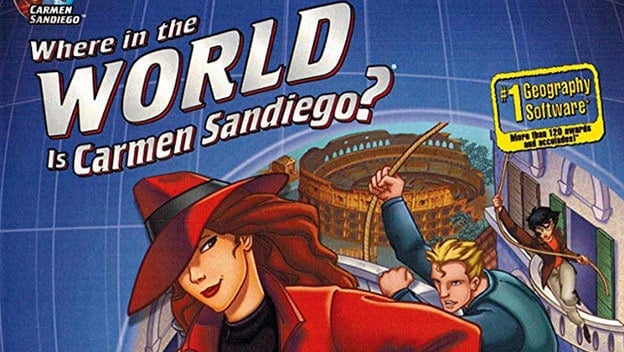When we think of educational games, we can’t help but think of all the games in the past—especially those old enough to remember playing these games on the Apple II—that taught math or vocabulary. For example, the classic Number Munchers comes to mind almost immediately, something I have installed on my son’s iPad to help him learn math facts. But even back in the dark ages of gaming, we had educational games that never felt like educational games, because they were so darn fun. Two of these “ancient” franchises are still in circulation today, and they’re still nostalgically revered.
One of these series transformed my gaming life as a kid, and it was the very first game I was ever hooked on. I am talking about the nefarious Carmen Sandiego and her gang’s insistence upon stealing national treasures (and sometimes monuments) and then running all over the globe to get away. Players had to interview witnesses, find out what they could about the criminal to figure out who they are indeed looking for, and then decipher where they were fleeing to next.
It’s a puzzle game. It’s an adventure game. And you’re learning all about the geography and history of the world. The best part was you didn’t even realize you were doing the latter. You were so intent upon finding the thief, always crossing your fingers that maybe this time it was the elusive Carmen Sandiego herself.
Who knows how many hours I logged into my first Carmen Sandiego title, Where in the USA is Carmen Sandiego? I have a lot of fond memories of that one too, because my Dad would sit with me and help me solve the clues where to travel next. As soon as my character was in the Hall of Fame, I begged my mom for Where in the World and Where in Europe next. The last one I received was Where in Time is Carmen Sandiego? , and I had a blast with that. I think I uttered the words, “Wow graphics will not get better than this!” at the time.
By then, the game show was starting up, soon to be followed by the TV show. I was now in high school and considered gaming to be a silly hobby, but Carmen Sandiego never left me. To this day, I can spout endless knowledge about where certain landmarks are across the world. Useless knowledge? Some, sure, but I can rock a game of old school Trivial Pursuit.
The next “edutainment” game that never really felt like education was Oregon Trail . In junior high, some classes had two Apple IIs, and if we finished our work, we could play Oregon Trail on them. Sometimes brawls broke out over computer time.

While technically, yes, we were learning about the hardships settlers endured while traveling to Oregon, we never really saw it that way. It was more of an early survival game for us, and each playthrough became a trial of “how far we can make it this time before we all die of dysentery.” No matter how much we were missing vital supplies, we never starved or ran out of bullets, because we spent all of our money on bullets at the get-go so we would could always play the most fun part of the game: hunting for food. Were we poachers, killing everything in sight even though we could only take 100 pounds of food back to the wagon? You betcha! All buffalo and bear must die, and we have to prove our shooting skills by hitting those quick little rabbits and squirrels. Have. To.
The last edutainment game to spike on the educational game meter was Mario is Missing for the SNES. This game never got the traction it deserved, which was a crying shame. It was yet another educational game that never felt like it was one, much like the Carmen Sandiego titles.
Educational games for education certainly have their place in the world, but more games need to find a way to teach without feeling like it’s a school lesson. We know it’s possible, just need to find a developer willing to take that risk.
